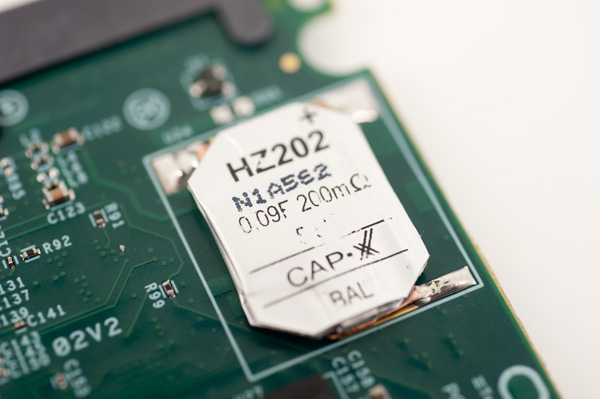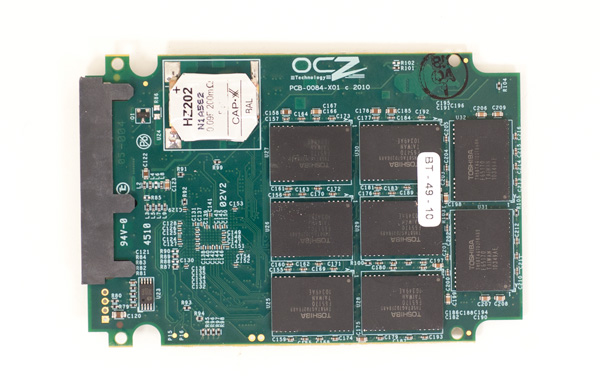OCZ Vertex 3 Pro Preview: The First SF-2500 SSD
by Anand Lal Shimpi on February 17, 2011 3:01 AM ESTToday: Toshiba 32nm Toggle NAND, Tomorrow: IMFT 25nm
The Vertex 3 Pro sample I received is a drive rated at 200GB with 256GB of NAND on-board. The SF-2682 controller is still an 8-channel architecture and OCZ populates all 8 channels with a total of 16 NAND devices. OCZ selected Toshiba 32nm Toggle Mode MLC NAND for these early Vertex 3 Pro samples however final shipping versions might transition to IMFT 25nm. The consumer version (Vertex 3) will use IMFT 25nm for sure.
Each of the 16 NAND devices on board is 16GB in size. Each package is made up of four die (4GB a piece) and two planes per die (2GB per plane). Page sizes have changed. The older 34nm Intel NAND used a 4KB page size and a 1MB block size. For Toshiba's 32nm Toggle NAND pages are now 8KB and block size remains unchanged. The move to 25nm will finally double block size as well.
Remember from our earlier description of SandForce's architecture that its data redundancy requires a single die's worth of capacity. In this case 4GB of the 256GB of NAND is reserved for data parity and the remaining 66GB is used for block replacement (either cleaning or bad block replacement). The 200GB drive has a 186GB formatted capacity in Windows.
This is a drive with an enterprise focus so the 27.2% spare area is not unusual. You can expect the consumer versions to set aside less spare area, likely at little impact to performance.

The 0.09F supercap, a feature of the enterprise level SF-2500 controller. This won't be present on the client Vertex 3.
The Vertex 3 Pro is still at least a month or two away from shipping so pricing could change, but right now OCZ is estimating sales at between $3.75 and $5.25 per GB. The client focused Vertex 3 will be significantly cheaper - I'd estimate somewhere north (but within range) of what you can currently buy Vertex 2 drives for.
| OCZ Vertex 3 Pro Pricing | |||||
| 100GB | 200GB | 400GB | |||
| MSRP | $525.00 | $775.00 | $1350.00 | ||
| Cost per GB | $5.35/GB | $3.875/GB | $3.375/GB | ||
Both the Vertex 3 and Vertex 3 Pro are expected to be available as early as March, however as always I'd be cautious in jumping on a brand new controller with brand new firmware without giving both some time to mature.












144 Comments
View All Comments
sheh - Thursday, February 17, 2011 - link
Why's data retention down from 10 years to 1 year as the rewrite limit is approached?Does this mean after half the rewrites the retention is down to 5 years?
What happens after that year, random errors?
Is there drive logic (or standard software) to "refresh" a drive?
AnnihilatorX - Saturday, February 19, 2011 - link
Think about how Flash cell works. There is a thick Silicon Dixoide barrier separating the floating gate with the transistor. The reason they have a limited write cycle is because the Silion dioxide layer is eroded when high voltages are required to pump electrons to the floating gate.As the SO2 is damaged, it is easier for the electrons in the floating gate to leak, eventually when sufficient charge is leaked the data is loss (flipped from 1 to 0)
bam-bam - Thursday, February 17, 2011 - link
Thanks for the great preview! Can’t wait to get a couple of these new SDD’s soon.I’ll add them to an even more anxiously-awaited high-end SATA-III RAID Controller (Adaptec 6805) which is due out in March 2011. I’ll run them in RAID-0 and then see how they compare to my current set up:
Two (2) Corsair P256 SSD's attached to an Adaptec 5805 controller in RAID-0 with the most current Windows 7 64-bit drivers. I’m still getting great numbers with these drives, almost a year into heavy, daily use. The proof is in pudding:
http://img24.imageshack.us/img24/6361/2172011atto....
(1500+ MB/s read speeds ain’t too bad for SATA-II based SSD’s, right?)
With my never-ending and completely insatiable need-for-speed, I can’t wait to see what these new SATA-III drives with the new Sand-Force controller and a (good-quality) RAID card will achieve!
Quindor - Friday, February 18, 2011 - link
Eeehrmm.....Please re-evaluatue what you have written above and how to preform benchmarks.
I too own a Adaptec 5805 and it has 512MB of cache memory. So, if you run atto with a size of 256MB, this fits inside the memory cache. You should see performance of around 1600MB/sec from the memory cache, this is in no way related to what your subsystem storage can or cannot do. A single disk connected to it but just using cache will give you exactly the same values.
Please rerun your tests set to 2GB and you will get real-world results of what the storage behind the card can do.
Actually, I'm a bit surprised that your writes don't get the same values? Maybe you don't have your write cache set to write back mode? This will improve performance even more, but consider using a UPS or a battery backup cache module before doing so. Same thing goes for allowing disk cache or not. Not sure if this settings will affect your SSD's though.
Please, analyze your results if they are even possible before believing them. Each port can do around 300MB/sec, so 2x300MB/sec =/= 1500MB/sec that should have been your first clue. ;)
mscommerce - Thursday, February 17, 2011 - link
Super comprehensible and easy to digest. I think its one of your best, Anand. Well done!semo - Friday, February 18, 2011 - link
"if you don't have a good 6Gbps interface (think Intel 6-series or AMD 8-series) then you probably should wait and upgrade your motherboard first""Whenever you Sandy Bridge owners get replacement motherboards, this may be the SSD you'll want to pair with them"
So I gather AMD haven't been able to fix their SATA III performance issues. Was it ever discovered what the problem is?
HangFire - Friday, February 18, 2011 - link
The wording is confusing, but I took that to mean you're OK with Intel 6 or AMD 8.Unfortunately, we may never know, as Anand rarely reads past page 4 or 5 of the comments.
I am getting expected performance from my C300 + 890GX.
HangFire - Friday, February 18, 2011 - link
OK here's the conclusion from 3/25/2010 SSD/Sata III article:"We have to give AMD credit here. Its platform group has clearly done the right thing. By switching to PCIe 2.0 completely and enabling 6Gbps SATA today, its platforms won’t be a bottleneck for any early adopters of fast SSDs. For Intel these issues don't go away until 2011 with the 6-series chipsets (Cougar Point) which will at least enable 6Gbps SATA. "
So, I think he is associating "good 6Gbps interface) with 6&8 series, not "don't have" with 6&8.
semo - Friday, February 18, 2011 - link
Ok I think I get it thanks HangFire. I remember that there was an article on Anandtech that tested SSDs on AMD's chipsets and the results weren't as good as Intel's. I've been waiting ever since for a follow up article but AMD stuff doesn't get much attention these days.BanditWorks - Friday, February 18, 2011 - link
So if MLC NAND mortality rate ("endurance") dropped from 10,000 cycles down to 5,000 with the transition to 34nm manufacturing tech., does that mean that the SLC NAND mortality rate of 100,000 cycles went down to ~ 50,000?Sorry if this seems like a stupid question. *_*